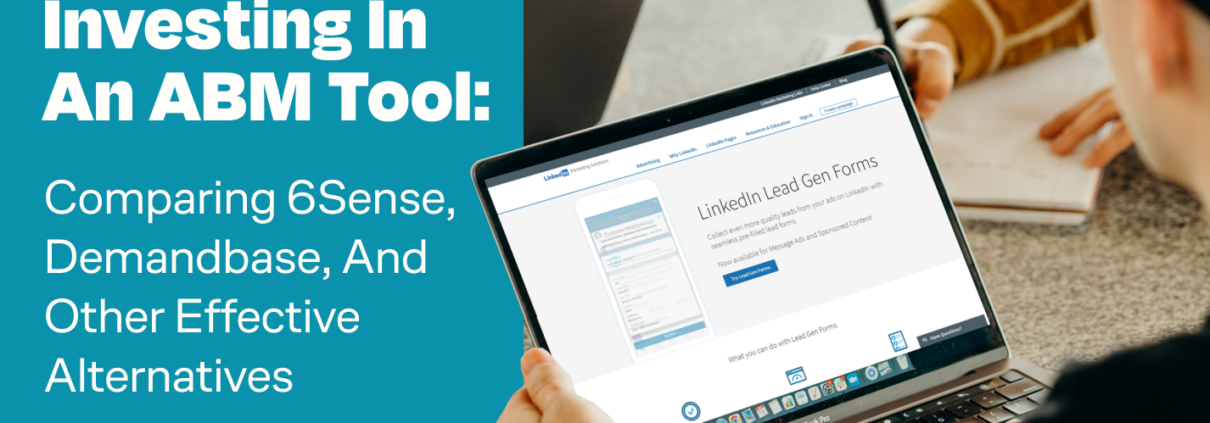Investing in an ABM Tool: Comparing 6Sense, Demandbase, and Other Effective Alternatives
If you’re a B2B org, chances are you could benefit from adopting an account-based marketing approach.
But hey, we get it, starting out can seem like a mountain of work.
You may find yourself in this position and ask, what tools do I use? What the hell is RevOps, anyways? Lead generation and demand generation is the same thing, right? How do I get on the same page with my sales and go-to-market teams? If you’re looking to kickstart an ABM program or you’ve launched one but aren’t seeing the results you want, you’re in the right place.
Let’s dive in together!
Why We Love Account-Based Marketing:
The B2B buying journey is complex. If you’re not using ABM, you have a contact-level attribution model. That means that the revenue is credited solely to the contact who signs the deal.
This is inherently flawed. 6sense published a report in 2024 that estimates that the average B2B deal of over $10,000 has 9 people on the buying committee. How on earth do you create a fair attribution model when one contact came in from word of mouth, one from a trade show, one from paid social, and the rest via an email chain?
ABM recognizes that sales and marketing must work together for the larger overall goal: marketing creates touchpoints along the buying cycle via educating target buyers for sales to close deals. A mature ABM organization doesn’t give a single thought about “whose revenue” it is – because at the end of the day, dollar bills are the same on the P+L sheet no matter where they come from.
Our Approach to Account-Based Marketing
Our approach to account-based marketing is fairly simple, and it starts with three questions: what is your inbound marketing strategy today, how effective is your current approach, and what’s your level of marketing sophistication?
- What is your inbound strategy today? Often, organizations in the scaleup phase don’t have an inbound strategy, at least not a real one. They may get the occasional inbound lead that is actually a referral, but if you can’t clearly articulate how you’re generating demand, you don’t have an inbound strategy.
- How effective is your current marketing strategy? If they’re talking to an agency, chances are they aren’t happy with their results. However, is that because there is an unrealistic expectation on marketing? Or, rather, is marketing responsible for an OKR that drives little business value? If you don’t know – do some digging before getting to question number three.
- What’s your organization’s level of marketing sophistication? This is difficult to quantify, but when you start to have discussions about ABM, a few things become clear quickly. Fair warning though, this question can turn into about a dozen followup questions, which is why we save it for last.
- Is the organization set up to receive inbound leads? How are deals being worked? Who controls budget? Who represents marketing at important organizational meetings? Are you a leads, or a revenue KPI organization? What tools do you currently have in place to measure success? What does success even look like?
Depending on these answers, we will recommend a varying degree of account-based marketing, in which the level of sophistication and investment increases or decreases based on what needs to take place.
For each of these, we recommend an account-based measurement approach, not a contact-level measurement approach. It’s far more important for the revenue from the target account to close than who gets credit.
We’ll tier these into a few organizational personas:
- Entry-level ABM
- Roller Coaster ABM
- Legacy ABM
Entry-Level ABM:
If you’re new, or have no existing inbound volume, don’t get started by buying a fancy tool, like Demandbase or 6sense. We’re a huge fan of these platforms (and speak more on them later), but the last thing you need on your P+L before validating your ICP, target accounts, or more is a six-figure software.
Instead, we recommend taking a scrappier approach. Ask yourself these questions:
- If we could sign 100 new companies tomorrow, who would they be? (Note: it doesn’t have to be 100, but for this example, we’re using it. The actual number you’ll need depends on a lot of things, including organization size at the organizations you’re marketing to.)
- What types of businesses are my best customers?
- Who at the organizations are the people buying my product or service, and who else at the organization is involved in the buying process? Who is the final decision maker?
- What materials do I have that speak to my target audience? If I don’t have any – how can I create something that will be valuable and educate my audience as to what I do, and that I know the problems they are dealing with daily?
These aren’t super hard questions to answer, but it may take some time (and grunt work using ChatGPT, or AI for Work). We recommend starting with a lead generation approach to validate that you are reaching the right personas at target companies, and then once you feel confident in your ad targeting, expanding into a demand generation strategy. Which brings us to
Roller Coaster ABM:
If you’re a marketer at an organization using an ABM strategy that is currently measured on your ability to bring in MQLs, this one is for you.
Chances are, you are caught in a roller coaster of lead optimization, and your love of your job depends on what your CPMQL is on any given day. Your biggest challenge? Attribution, and justifying the expense to finance and revenue operations when content downloads don’t turn into sales opportunities. Likely, your organization has a “me” mentality, and not a “we” approach to revenue generation.
The good news is that there is an answer to your problem, and it’s measurement. The easiest way to get out of Roller Coaster ABM is to:
- Take a step back, and audit your lead and revenue pipeline. Chances are, your content downloads are converting into opportunities at a sub-5% metric, and that’s not sustainable.
- Evaluate what other KPIs exist within your revenue pipeline that you and sales both agree are problematic: is it velocity? Is it win rate? Is it deal size? Is it new logo acquisition?
- Assemble a plan of attack for how you could measure the effects of one of those KPIs with a structured (non-lead) generating test.
Each one of the KPIs listed above can be tackled with a structured account based marketing test, using control and test variations. If velocity is an issue, you can market to half of your pipeline with content designed to nurture them through the funnel. This content has to be ungated and able to be consumed by prospects at target accounts. Over time, you can begin to measure the uplift in velocity, and start to create internal buy-in for an account-based measurement instead of a contact level attribution model.
This journey won’t, and can’t be easy. It takes a humble and dedicated marketing leader to turn the conversation from “how can I get more leads” to “how can marketing better support sales and revenue generation?”. This process can take a year, maybe even more to create internal adoption – and even then, can lead to a lot of internal skeptcism, so have the narrative and data ready at all times.
Legacy ABM:
Legacy ABM organizations are organizations that have a fully bought-in revenue, sales, and marketing team to a “we”, not “me” mentality. In our experience, these are the least common type of organizations, but they do exist!
A Legacy ABM organization has to have a test-and-learn mindset to continue evolving processes, systems, tools, and teams. If they don’t, they’ll get stagnant, and likely end up back at the Roller Coaster ABM approach.
There’s a lot to learn from what successful ABM operations do, and the most common traits we’ve found are:
- They constantly are evolving their approach to fit the needs of their revenue goals – tailoring their strategy based on the various stages of the buying process.
- Their content, collateral, and messaging speaks authentically to their target audience. No faking it.
- They invest in the full funnel – from awareness through to retention.
- They use all three ABM approaches: one-to-many, one to few, and one-to-one across marketing and sales.
- Marketing, sales, and revenue operations meet and connect frequently about goals, areas of opportunity, and how they can work together.
- They use intent data from providers such as 6sense to help inform their priorities and share insights across the organization.
The biggest issue many Legacy ABM organizations face is scalability, and finding a partner or approach that allows them to find the right measurement and paid strategies to unlock more growth. Often, they’ll use a dedicated partner to manage the paid strategies, while they continue to own content production and RevOps themselves.
When to Buy a Tool While Setting up an Account Based Marketing Approach:
There are several different types of tools you can leverage in account-based marketing, and depending on their level of sophistication can range between a few thousand, to well over a hundred thousand dollars to invest in. We recommend holding on investing in a true ABM tool until you’re in at least the “Roller Coaster ABM” persona, and perhaps beyond, where you can clearly measure the benefit of having the tools to scale results.
To run a successful ABM strategy, you’ll need at least the following tools and resources, so also consider the total investment required when deciding whether or not to buy a tool.
- An account targeting list: this can be generated manually (difficult) or via a tool using filters and intent data.
- A CRM: Your CRM should be your source of truth for sales and deal activity.
- A content marketing strategy: regardless of stage in ABM, you’ll need to have content to market that speaks directly to your target audience.
- Money and time: to market, you’ll have to invest in ads on LinkedIn (most likely) or other ABM channels such as Stackadapt. Results also take time, so having a clear roadmap and timeline is helpful.
Comparing ABM Tools:
Our favorite tool: 6sense
6sense was named as a leader in the Magic Quadrant from Gartner in 2024. With dedicated CSMs and onboarding support, 6sense can help take your account targets and help you tier your spend based on actions your accounts are taking right now. If an account is showing high levels of intent? It can automatically move to a new marketing segment to continue to nurture it to a state of conversion.
Pros: |
Cons: |
|
|
Other Intent Data Providers: Demandbase
Demandbase is another category leader in intent and ABM data. However, in our experience, is built a little more to be “out of the box” than 6sense. This can be beneficial to less sophisticated organizations who need less customization, but also can be a limiting factor for RevOps teams who are looking for more robust reporting and modelling.
Pros: |
Cons: |
|
|
Other Intent Providers: ZoomInfo Buying Signals
ZoomInfo is a leading provider of company contacts and now, Buying Signals. No longer just a place to get enriched contact data, you can use ZoomInfo data to measure web activity, technographics, and more. In our experience, if you’re using a provider such as 6sense or DemandBase, you likely are using ZoomInfo already for enriching contact data, but this is another potential area to explore if you are looking for an intent-based solution.
Pros: |
Cons: |
|
|
Other ABM Tools We’re Excited About and Trialling:
The ABM space is continuing to evolve, and with that, new tools and opportunities continue to present themselves. Currently, we’re using all sorts of new tools and will be reporting back on their use case.
- R!B2B: Identifies contacts that visit your website, and sends their contact data back to you in Slack
- Apollo.io: Newer to the enriched contact game than ZoomInfo, they are disrupting the go to market process and motion.
- Terminus: A premium DSP that allows you to market to target accounts and personas on premium ad inventory.
Ready to Supercharge Your ABM Strategy?
If you’re new to ABM or if you’re stuck in the Roller Coaster ABM, we’re happy to help. Our team of growth strategists, content marketers, lifecycle strategists, designers, and paid experts are able to plug into your existing sales and marketing functions to help take you to the next level. Let’s talk!

Richard has spent the last five years working at digital agencies, exploring various industries and company lifecycles. I’ve created and implemented growth campaigns on just about every platform for startups, $20,000,000 a year companies, and everything in-between. When not at work, I can be found cheering on the Penguins or Steelers, spending time with my wife and son, playing disc golf, baking, or walking my dogs.





